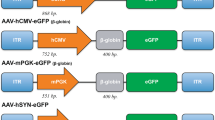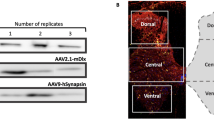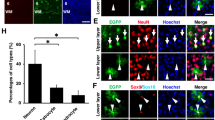Abstract
We designed a new promoter that drives transgene expression in an exclusively neuron-specific manner. The promoter of superior cervical ganglion10 (SCG10), expressed in neurons, was further modified to enhance its neuron specificity and activity by changing its length and fusing a multiple neuronal restrictive silencer element (NRSE) to its upstream or downstream regions. The promoter, which contained 2 kb original promoter length and two extra NRSEs in its downstream region, eventually exhibited remarkable neuron specificity as well as strong activity. To further amplify the promoter activity, the promoter was introduced into a Cre recombinase (Cre)-expressing adenovirus, and subsequent combination with Cre-inducible enhanced green fluorescence protein (EGFP)-expressing adenovirus vector, which has much stronger general promoter, resulted in a remarkably strong gene expression exclusively in neuronal cells of mixed cultures and in an animal model. This system is also applicable to astrocyte-specific expression; for instance, by changing the Cre promoter cassette to an astrocyte-specific promoter. The present relatively compact promoter combined with Cre/loxP system could be useful for a wide range of transgene experiments in vivo as well as for clinical applications.
This is a preview of subscription content, access via your institution
Access options
Subscribe to this journal
Receive 12 print issues and online access
$259.00 per year
only $21.58 per issue
Buy this article
- Purchase on Springer Link
- Instant access to full article PDF
Prices may be subject to local taxes which are calculated during checkout



Similar content being viewed by others
References
Horellou P, Vigne E, Castel MN, Barneoud P, Colin P, Perricaudet M et al. Direct intracerebral gene transfer of an adenoviral vector expressing tyrosine hydroxylase in a rat model of Parkinson's disease. Neuroreport 1994; 6: 49–53.
Miyaguchi K, Maeda Y, Kojima T, Setoguchi Y, Mori N . Neuron-targeted gene transfer by adenovirus carrying neural-restrictive silencer element. Neuroreport 1999; 10: 2349–2353.
Navarro V, Millecamps S, Geoffroy MC, Robert JJ, Valin A, Mallet J et al. Efficient gene transfer and long-term expression in neurons using a recombinant adenovirus with a neuron-specific promoter. Gene Therapy 1999; 6: 1884–1892.
Millecamps S, Kiefer H, Navarro V, Geoffroy MC, Robert JJ, Finiels F et al. Neuron-restrictive silencer elements mediate neuron specificity of adenoviral gene expression. Nat Biotechnol 1999; 17: 865–869.
Schoenherr CJ, Anderson DJ . Silencing is golden: negative regulation in the control of neuronal gene transcription. Curr Opin Neurobiol 1995; 5: 566–571.
Bessis A, Champtiaux N, Chatelin L, Changeux JP . The neuron-restrictive silencer element: a dual enhancer/silencer crucial for patterned expression of a nicotinic receptor gene in the brain. Proc Natl Acad Sci USA 1997; 94: 5906–5911.
Kallunki P, Edelman GM, Jones FS . The neural restrictive silencer element can act as both a repressor and enhancer of L1 cell adhesion molecule gene expression during postnatal development. Proc Natl Acad Sci USA 1998; 95: 3233–3238.
Mori N, Schoenherr C, Vandenbergh DJ, Anderson DJ . A common silencer element in the SCG10 and type II Na+ channel genes binds a factor present in nonneuronal cells but not in neuronal cells. Neuron 1992; 9: 45–54.
Sato Y, Tanaka K, Lee G, Kanegae Y, Sakai Y, Kaneko S et al. Enhanced and specific gene expression via tissue-specific production of Cre recombinase using adenovirus vector. Biochem Biophys Res Commun 1998; 244: 455–462.
Forss-Petter S, Danielson PE, Catsicas S, Battenberg E, Price J, Nerenberg M et al. Transgenic mice expressing beta-galactosidase in mature neurons under neuron-specific enolase promoter control. Neuron 1990; 5: 187–197.
Kugler S, Meyn L, Holzmuller H, Gerhardt E, Isenmann S, Schulz JB et al. Neuron-specific expression of therapeutic proteins: evaluation of different cellular promoters in recombinant adenoviral vectors. Mol Cell Neurosci 2001; 17: 78–96.
Gu H, Zou YR, Rajewsky K . Independent control of immunoglobulin switch recombination at individual switch regions evidenced through Cre-loxP-mediated gene targeting. Cell 1993; 73: 1155–1164.
Sato Y, Shiraishi Y, Furuichi T . Cell specificity and efficiency of the Semliki forest virus vector- and adenovirus vector-mediated gene expression in mouse cerebellum. J Neurosci Methods 2004; 137: 111–121.
Honma M, Namikawa K, Mansur K, Iwata T, Mori N, Iizuka H et al. Developmental alteration of nerve injury induced glial cell line-derived neurotrophic factor (GDNF) receptor expression is crucial for the determination of injured motoneuron fate. J Neurochem 2002; 82: 961–975.
Hall LL, Borke RC, Anders JJ . Transection or electrical stimulation of the hypoglossal nerve increases glial fibrillary acidic protein immunoreactivity in the hypoglossal nucleus. Brain Res 1989; 490: 157–161.
Omori N, Mizuguchi H, Ohsawa K, Kohsaka S, Hayakawa T, Abe K et al. Modification of a fiber protein in an adenovirus vector improves in vitro gene transfer efficiency to the mouse microglial cell line. Neurosci Lett 2002; 324: 145–148.
Robert JJ, Geoffroy MC, Finiels F, Mallet J . An adenoviral vector-based system to study neuronal gene expression: analysis of the rat tyrosine hydroxylase promoter in cultured neurons. J Neurochem 1997; 68: 2152–2160.
Goujet-Zalc C, Babinet C, Monge M, Timsit S, Cabon F, Gansmuller A et al. The proximal region of the MBP gene promoter is sufficient to induce oligodendroglial-specific expression in transgenic mice. Eur J Neurosci 1993; 5: 624–632.
Wagner EF, Vanek M, Vennstrom B . Transfer of genes into embryonal carcinoma cells by retrovirus infection: efficient expression from an internal promoter. EMBO J 1985; 4: 663–666.
Acknowledgements
We thank Drs I Saito and Y Kanegae (University of Tokyo, Japan) for the adenovirus transfer vectors (pAxAwNCre, pAxCALNLw), Dr J Miyazaki (Osaka University, Japan) for the CAG promoter, Dr N Mori (Nagasaki University, Japan) for SCG10 promoter plasmids, Dr K Ikenaka (National Institute for Physiological Science, Japan) for the GFAP promoter plasmid, Dr JG Sutcliffe (The Scripps Research Institute, USA) for NSE promoter plasmid, Dr S Kugler (University of Tübingen, Germany) for Synapsin 1 promoter plasmid, and Dr S Yoshida (Asahikawa Medical College) for his helpful comments for writing this manuscript. This study was supported in part by grants from MEXT.
Author information
Authors and Affiliations
Corresponding author
Additional information
Supplementary Information accompanies the paper on the Gene Therapy website (http://www.nature.com/gt).
Supplementary information
Rights and permissions
About this article
Cite this article
Namikawa, K., Murakami, K., Okamoto, T. et al. A newly modified SCG10 promoter and Cre/loxP-mediated gene amplification system achieve highly specific neuronal expression in animal brains. Gene Ther 13, 1244–1250 (2006). https://doi.org/10.1038/sj.gt.3302779
Received:
Revised:
Accepted:
Published:
Issue Date:
DOI: https://doi.org/10.1038/sj.gt.3302779
Keywords
This article is cited by
-
Evaluation of helper-dependent canine adenovirus vectors in a 3D human CNS model
Gene Therapy (2016)
-
Silencer-delimited transgenesis: NRSE/RE1 sequences promote neural-specific transgene expression in a NRSF/REST-dependent manner
BMC Biology (2012)
-
Modifications to the INSM1 promoter to preserve specificity and activity for use in adenoviral gene therapy of neuroendocrine carcinomas
Cancer Gene Therapy (2012)



